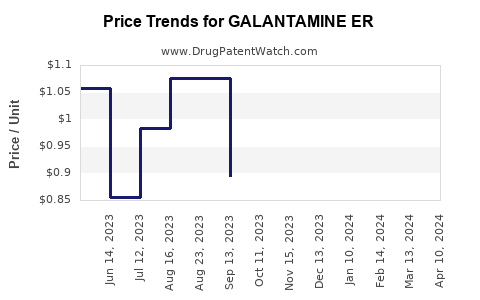Drug Price Trends for GALANTAMINE ER
✉ Email this page to a colleague

Average Pharmacy Cost for GALANTAMINE ER
| Drug Name | NDC | Price/Unit ($) | Unit | Date |
|---|---|---|---|---|
| GALANTAMINE ER 24 MG CAPSULE | 65862-0746-30 | 1.14071 | EACH | 2024-11-20 |
| GALANTAMINE ER 16 MG CAPSULE | 65862-0745-30 | 0.91202 | EACH | 2024-11-20 |
| GALANTAMINE ER 24 MG CAPSULE | 47335-0837-83 | 1.14071 | EACH | 2024-11-20 |
| GALANTAMINE ER 8 MG CAPSULE | 47335-0835-83 | 0.80108 | EACH | 2024-11-20 |
| GALANTAMINE ER 16 MG CAPSULE | 47335-0836-83 | 0.91202 | EACH | 2024-11-20 |
| >Drug Name | >NDC | >Price/Unit ($) | >Unit | >Date |
Best Wholesale Price for GALANTAMINE ER
| Drug Name | Vendor | NDC | Count | Price ($) | Price/Unit ($) | Unit | Dates | Price Type |
|---|---|---|---|---|---|---|---|---|
| GALANTAMINE ER 8MG CAP | Johnson & Johnson Health Care Systems, Inc. obo Patriot Pharm | 10147-0891-03 | 30 | 29.84 | 0.99467 | EACH | 2023-01-01 - 2027-12-31 | FSS |
| GALANTAMINE ER 16MG CAP | Johnson & Johnson Health Care Systems, Inc. obo Patriot Pharm | 10147-0892-03 | 30 | 0.50 | 0.01667 | EACH | 2023-01-01 - 2027-12-31 | FSS |
| GALANTAMINE ER 24MG CAP | Johnson & Johnson Health Care Systems, Inc. obo Patriot Pharm | 10147-0893-03 | 30 | 5.39 | 0.17967 | EACH | 2023-01-01 - 2027-12-31 | FSS |
| >Drug Name | >Vendor | >NDC | >Count | >Price ($) | >Price/Unit ($) | >Unit | >Dates | >Price Type |


